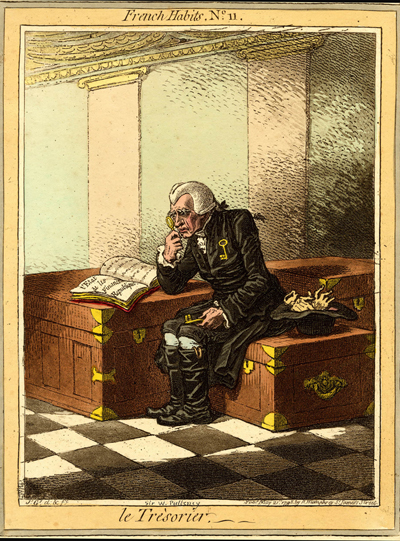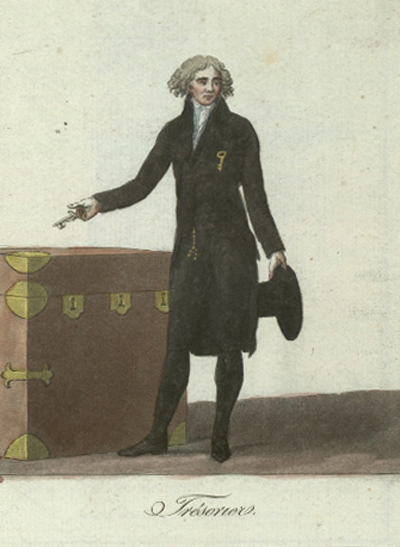French Habits: le Trésorier
This is the eleventh in a series of twelve plates in which Gillray portrays members of the Whig opposition wearing the new ceremonial robes designed by Jacques-Louis David for the prominent public officials of the French Directorate. In this plate, Sir William Pulteney is shown as le Trésorier.

© Trustees of the British Museum
As explained in the English "translation" of the French specification, the Treasurer's dress consists of a "common black coat; on the left side a small key embroidered in gold." In the French illlustration, the treasurer is standing with key in hand before a strong box. In Gillray's version, Pulteney is seated on one strong box while surrounded with others, one of which he is using as a desk. He is examining a book inscribed "L'Etat de les Finances . . . République" with what appears to be a magnifying glass.

of the Robes Prescribed for le Trésorier [1796]
There are at least two reasons why Pulteney might have been chosen by Gillray to represent the Treasurer in this new republican administration. First, he was reputed to be among the richest commoners in England and something of a miser. Who better to scrutinize the national finances to look for savings? Indeed his parsimony may be suggested by the fact that he is using the treasury strongboxes to double as desk and chair.
Another reason, however, was that Pulteney's name had recently been mentioned as a possible candidate for Chancellor of the Exchequer in a rumored administration under Lord Moira. That possibility had been satirized in "The Ode to Lord Moira" in the pro-Pitt Anti-Jacobin Review, and indeed Gillray had already drafted a print of the same name which included Pulteney.
Sources and Reading
- Commentary from the British Museum on French Habits: le Trésorier.
- "Sir William Pulteney, 5th Baronet," Wikipedia
- Collection des nouveaux costumes des autorités constituées, civils et militaires
- Dresses of the Representatives of the People. . .
- Thomas Wright and R.H. Evans, Historical and Descriptive Account of the Caricatures of James Gillray #195
- Thomas Wright and Joseph Grego, The Works of James Gillray, the Caricaturist; With the History of His Life and Times pp. 239-240.
NEXT: French Habits 12
Comments & Corrections
NOTE: Comments and/or corrections are always appreciated. To make that easier, I have included a form below that you can use. I promise never to share any of the info provided without your express permission.